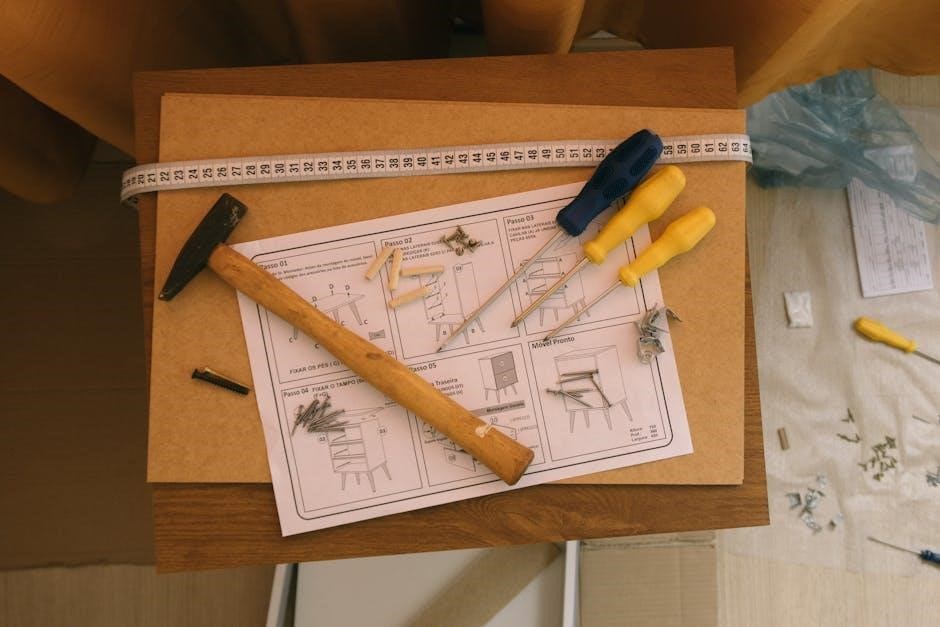Safety Precautions and Guidelines
Always follow safety guidelines when operating Lewis Pumps. Avoid overpressure, ensure proper grounding, and wear protective gear. Failure to comply may result in injury or equipment damage.
1.1 Important Safety Considerations
When working with Lewis Pumps, always adhere to safety guidelines to prevent accidents. Ensure proper installation and operation as outlined in the manual. Wear protective gear, including gloves and safety glasses, to minimize risks. Avoid overpressure, which can lead to equipment failure; Keep the area around the pump clear of obstructions and ensure proper ventilation. Never operate the pump near open flames or sparks, as certain models may handle flammable materials. Regularly inspect hoses and connections for signs of wear or damage. Familiarize yourself with emergency shutdown procedures and ensure all personnel are trained in safety protocols. Failure to follow these considerations may result in physical injury or equipment damage. Always prioritize caution when handling hazardous materials or operating high-pressure systems.
1.2 Safety Terminology and Emergency Procedures
Understand key safety terms like Emergency Shutdown Device (ESD), which halts pump operation immediately. Familiarize yourself with PSI (pounds per square inch) and maximum operating pressure to avoid overpressure. In case of pump failure, isolate the system and shut off power. For leaks, contain spills using absorbent materials and ventilate the area. Refer to the manual for specific emergency procedures. Always follow proper shutdown sequences to prevent residual pressure buildup. Keep a fire extinguisher nearby and ensure all personnel know evacuation routes. Regularly practice emergency drills to ensure preparedness. Consult the manual for detailed instructions on handling specific scenarios, such as brake bleeding or reservoir leakage, to maintain safety and prevent accidents.
Product Overview and Features
Lewis Pumps are renowned for durability in corrosive environments, featuring elastomer-lined components for superior resistance. Designed for efficiency, they offer interchangeable parts, ensuring minimal downtime.
Lewis Pumps, manufactured by Weir Minerals, are globally recognized for their reliability in harsh industrial applications, particularly in the sulphur, sulphuric acid, and phosphoric acid industries. With a history dating back to 1914, these pumps are engineered to withstand extreme conditions, offering durability and efficiency. Their design incorporates advanced materials like elastomers to resist corrosion and abrasion, ensuring long service life. Widely used in chemical processing and mining, Lewis Pumps are known for their simplicity, ease of maintenance, and interchangeable parts. This makes them a preferred choice for industries requiring consistent performance and minimal downtime. Their reputation is built on innovation and a commitment to meeting the toughest industrial challenges.
2.2 Key Features and Benefits
Lewis Pumps are designed with robust construction and advanced features, making them ideal for demanding industrial applications. Their elastomer-lined components provide exceptional resistance to corrosion and abrasion, ensuring longevity. The pumps are engineered for simplicity, allowing easy maintenance and reducing downtime. Standard tools and interchangeable parts facilitate quick servicing, enhancing operational efficiency. They handle high temperatures and aggressive fluids effectively, making them suitable for sulphuric acid and phosphoric acid processes. The pumps also offer reliable performance with minimal maintenance needs, lowering overall operational costs. These features and benefits make Lewis Pumps a trusted choice in industries requiring durability and consistent performance in challenging environments.

Installation and Setup
Ensure proper alignment and avoid air pockets in piping. Slope connections to prevent fluid accumulation. Secure the pump firmly to prevent vibration during operation for optimal performance.
3.1 Pre-Installation Checklist and Preparation
Before installing Lewis Pumps, ensure the site is prepared. Check for level ground and proper drainage. Verify all components and tools are available. Inspect piping for damage and ensure compatibility with pump specifications. Review the manual for specific requirements. Ensure power supply matches pump voltage and phase; Pre-assemble any components as instructed. Secure necessary permits and follow local regulations. Protect the area from contaminants and ensure safe working conditions. Proper preparation prevents delays and ensures smooth operation.
3.2 Piping and Alignment Guidelines
Proper piping and alignment are crucial for Lewis Pumps. Ensure all piping is securely connected and free from leaks. Avoid sharp bends or kinks that could restrict flow. Align the pump and motor shafts accurately to prevent vibration. Use flexible couplings to absorb minor misalignments. Slope suction piping downward to prevent air pockets. Ensure discharge piping is properly supported to avoid stress on the pump. Follow recommended pipe sizes to maintain optimal flow rates. Regularly inspect piping for wear or damage. Proper alignment and piping configuration maximize efficiency and extend pump lifespan. Always refer to the manual for specific guidelines to ensure safe and effective operation.

Operating Instructions
Start the pump gradually, monitor its performance, and adjust settings as needed. Ensure smooth operation by following the manual’s guidelines for optimal functionality and safety standards.
4.1 Starting and Running the Pump
Before starting, ensure all connections are secure and the system is properly primed. Gradually engage the power source and monitor for leaks or unusual noises. Once operational, observe pressure gauges and flow rates to ensure they align with recommended levels. Avoid sudden speed changes to maintain stability. If the pump is equipped with variable speed controls, adjust settings cautiously to prevent overload. Continuous operation should be monitored to prevent overheating or vibration. Always refer to the manual for specific startup procedures tailored to your Lewis Pump model. Proper initialization ensures efficiency, safety, and extends the pump’s lifespan. Never bypass safety features or ignore warning signs during operation.
4.2 Monitoring and Adjusting Pump Settings
Regularly monitor pressure gauges, flow meters, and temperature levels to ensure optimal performance. Adjust pump speed or pressure settings as needed, referencing the manual for specific guidelines. Gradual adjustments are crucial to prevent system instability. Observe the oil film on the stand pipe; if dry, shorten the turn buckle to increase pump action. Avoid sudden changes that could strain the pump or connected equipment. Document all adjustments for future reference and maintenance planning. Always use standard tools for adjustments to maintain compatibility and ensure safety. Continuous monitoring helps identify potential issues early, preventing downtime. Proper adjustment extends equipment lifespan and ensures efficient operation.
Maintenance and Servicing
Perform routine inspections, lubricate moving parts, and replace wear components promptly. Use standard tools for servicing, ensuring compatibility and interchangeability with older units for efficient maintenance.
5.1 Routine Maintenance Tasks
Regularly inspect the pump for wear and tear, paying attention to seals and gaskets. Clean or replace filters as needed to ensure optimal performance. Lubricate moving parts following the manufacturer’s recommendations to prevent friction and overheating. Check the suction and discharge lines for any blockages or leaks, addressing them promptly to avoid operational issues. Schedule periodic checks of the motor and drive systems to ensure proper alignment and function. Maintain a record of maintenance activities to track the pump’s condition and plan future servicing effectively. Always refer to the Lewis Pumps manual for specific guidance tailored to your model.
5.2 Replacement of Wear and Tear Parts
Replace worn components promptly to maintain efficiency and prevent damage. Use genuine Lewis Pumps parts for compatibility and reliability. When replacing seals or gaskets, ensure surfaces are clean and dry for a tight fit. Follow the manual’s torque specifications for bolts and connections. After replacing parts, test the pump at low pressure to check for leaks. Keep a stock of common wear items to minimize downtime. Regularly inspect impellers and casings for erosion, replacing them if damage exceeds acceptable limits. Always shut off power and drain fluids before starting any replacement work to ensure safety.

Troubleshooting Common Issues
Identify common issues like leaks, low pressure, or excessive noise. Check for blockages, worn seals, or misaligned parts. Address problems promptly to avoid further damage.
6.1 Identifying and Diagnosing Problems
Start by performing a visual inspection of the pump and its components. Look for signs of leakage, wear, or damage. Listen for unusual noises, such as grinding or vibration, which may indicate misalignment or worn parts. Check the suction and discharge lines for blockages or kinks. Refer to the troubleshooting section in the manual for common issues like low pressure or excessive noise. Use diagnostic tools, such as pressure gauges, to identify irregularities in system performance. For recurring problems, consult the advanced diagnostic techniques outlined in the manual. Always prioritize safety and shut down the pump before attempting any repairs or adjustments.

6.2 Advanced Diagnostic Techniques
For complex issues, utilize advanced diagnostic tools like pressure gauges and vibration analyzers to pinpoint problems. Measure flow rates and compare with expected performance. Check for pressure drops across the pump and piping system. Perform a thorough vibration analysis to detect imbalance or misalignment. Review maintenance history to identify patterns of wear or recurring faults. Use thermal imaging to detect overheating components. Consult specialized manuals or manufacturer guidelines for detailed diagnostic procedures. Always follow safety protocols before attempting advanced diagnostics, such as shutting down the pump and ensuring the system is depressurized. Document findings for future reference and to aid in repairs or part replacement. Advanced techniques ensure accurate diagnoses, minimizing downtime and extending pump lifespan.
